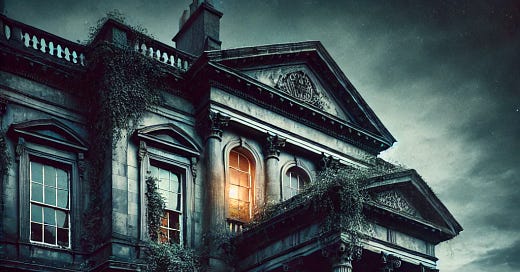Glasgow’s city center bustles with shoppers, street musicians, and bus lanes. Modern banks, coffee shops, and department stores dominate the skyline. But peel back the urban buzz, squint past the glass façades, and you might still catch a glimpse — faint, regal, fading — of a different Glasgow.
This was the Glasgow of the Tobacco Lords, the 18th-century merchant aristocrats who built their wealth on transatlantic trade and covered the city in grand Georgian stone. They didn’t just build Glasgow’s fortune — they built Glasgow itself. Their mansions, laid out like urban palaces, lined the new streets of the expanding town.
And while most are long gone, their ghosts remain — in names, in foundations, in whispers among the bricks.
Let’s take a walk through the lost mansions of the merchant kings.
From Counting House to Palace
The Tobacco Lords weren’t interested in modesty. Their wealth was new, but their tastes were aristocratic. With booming fortunes from tobacco imports, they did what new-money dynasties have always done: they built big.
They built stone townhouses on the finest new streets — Virginia Street, Queen Street, Ingram Street — streets named after colonies and monarchs, dripping with imperial significance.
Inside, their homes were fitted with the finest mahogany (often sourced through the same trade that brought them tobacco), intricate cornices, and chandeliers that reflected not just light but status. Some had vast drawing rooms, libraries, and private ballrooms.
They were designed to rival the mansions of London or the villas of Genoa. And in many cases, they succeeded.
One of the most striking belonged to William Cunninghame of Lainshaw, built in 1778 — a three-story, 5-bay townhouse complete with a stunning Corinthian portico. Today, you know it as the Gallery of Modern Art (GoMA) in Royal Exchange Square. But when it was first built, it wasn’t a gallery — it was a single-family home.
That’s how the Tobacco Lords rolled.
The Ones That Vanished
But most of these grand homes are now gone. Lost to time, fire, war, or the unrelenting march of modern development.
The Buchanan mansion at the head of Virginia Street, a stone’s throw from the Clyde, was once a beacon of elegance. It was demolished and replaced with the Union Bank of Scotland, and later modernized beyond recognition.
The Buck’s Head Hotel in Argyle Street was originally a private mansion owned by Provost Murdoch. It was turned into a hotel, and then eventually lost its identity in the waves of commercial expansion.
The Dunlop mansion once stood beside the Buck’s Head. Again, it gave way to expansion. A few stone fragments in the foundations are all that remain.
These weren’t just houses — they were symbols. Each one announced its owner’s place in the world. When they disappeared, so too did the last physical markers of a time when Glasgow’s wealth came from across the ocean, and its elite lived like lords.
The Clubhouses Within the Mansions
These mansions weren’t just residences — they were hubs of power, culture, and networking. Clubs like the famous Hodge-Podge Club, formed in 1752, often met within the lavish rooms of these merchant homes or nearby taverns like Cruikshank's, a fine establishment frequented by the elite.
The clubs were semi-secret, wildly exclusive, and deeply ritualistic. They were also hilariously human. Men smoked elaborate pipes, toasted local beauties, and roasted each other in verses — like Dr. John Moore’s iconic poem that affectionately mocked each member by name.
Some mansions even had custom-built rooms for these gatherings. You can imagine the scent of snuff and wine in the air, the sound of laughter echoing through plastered halls while a scarlet cloak hangs by the door.
These spaces weren’t just about status — they were about belonging to a merchant caste that saw itself as the ruling class of Glasgow.
And they were fiercely protective of it.
Ghosts That Still Whisper
Even though many of these grand homes are gone, the Tobacco Lords still haunt Glasgow — and not only in statues or street names. Their influence is architectural, economic, cultural.
Look closely at the layout of the Merchant City, at the wide, deliberate grid of its streets — that was their doing. The symmetry, the neo-classical columns, the love of opulence — that came from them.
Their clubs still exist too. The Western Club, the spiritual heir of the Hodge-Podge, remains one of Glasgow’s most elite private institutions. The Hodge-Podge Club itself still toasts its totem snuffbox, still chooses annual beauties to honor, and still sings the satirical songs of centuries past — just with newer names.
And then, there are the actual ghosts — the old mansions turned government offices, the stone staircases tucked behind modern glass, the foundations beneath shopping malls and galleries.
They remind us: Glasgow wasn't always grit and iron. Once, it was Georgian, golden, and grandeur.
A City of Memory and Marble
There’s something uniquely Glasgow about this legacy — a blend of immense ambition, dramatic rise, and bittersweet decline.
The mansions may be gone. The cloaks may be folded. The canes may be cracked. But the idea of the Tobacco Lord — the self-made aristocrat of commerce — still stalks the streets of the Merchant City.
Sometimes, in the shadow of GoMA or as you walk Virginia Street at dusk, you might hear a whisper from one of the old clubhouses:
“Pass the snuff, fill the bowl — and toast the ghosts who built this town.”





